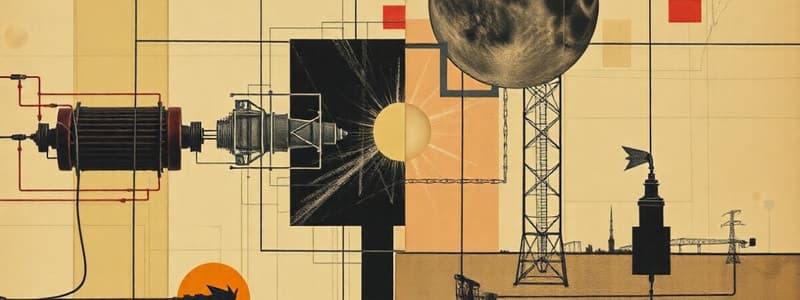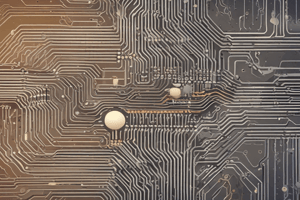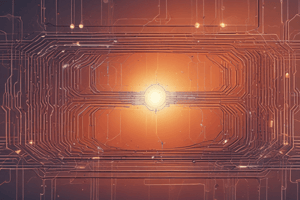Podcast
Questions and Answers
In a circuit with both external and internal resistance, how does the total circuit resistance affect the current according to Ohm's Law?
In a circuit with both external and internal resistance, how does the total circuit resistance affect the current according to Ohm's Law?
- The current is directly proportional to the total circuit resistance.
- The current is inversely proportional to the total circuit resistance. (correct)
- The current is proportional to the square of the total circuit resistance.
- The current is independent of the total circuit resistance.
What is the primary consequence of a short circuit in an electrical system, and why does this occur?
What is the primary consequence of a short circuit in an electrical system, and why does this occur?
- A significant increase in current because of a low-resistance path bypassing the intended load. (correct)
- A negligible change in current, as the voltage remains constant.
- A decrease in current due to increased resistance from the faulty insulation.
- A stabilized current due to balanced impedances within the circuit.
A circuit with a 12 V EMF source and an internal resistance of 1 Ohm experiences a short circuit. What is the short circuit current (I_sc) in the circuit?
A circuit with a 12 V EMF source and an internal resistance of 1 Ohm experiences a short circuit. What is the short circuit current (I_sc) in the circuit?
- 3 A
- 12 A (correct)
- 6 A
- 24 A
A lamp with a resistance of 6 Ohms is connected to a power source with an EMF of 3V and an internal resistance of 0.5 Ohms. What is the voltage across the lamp?
A lamp with a resistance of 6 Ohms is connected to a power source with an EMF of 3V and an internal resistance of 0.5 Ohms. What is the voltage across the lamp?
A power source with an EMF of 40 V and an internal resistance of 4 Ohms is connected to two resistors in series. If the measured current in the circuit is 2 A, and one of the resistors has a resistance of 12 Ohms, what is the resistance of the other resistor?
A power source with an EMF of 40 V and an internal resistance of 4 Ohms is connected to two resistors in series. If the measured current in the circuit is 2 A, and one of the resistors has a resistance of 12 Ohms, what is the resistance of the other resistor?
What distinguishes the role of non-Coulomb forces from Coulomb forces in maintaining a continuous electric current in a circuit?
What distinguishes the role of non-Coulomb forces from Coulomb forces in maintaining a continuous electric current in a circuit?
In the context of electrical circuits, how does the electromotive force (EMF) characterize the energy properties of a power source?
In the context of electrical circuits, how does the electromotive force (EMF) characterize the energy properties of a power source?
When is the voltage across the terminals of a power source equal to the EMF?
When is the voltage across the terminals of a power source equal to the EMF?
In a simple closed circuit with a power source (EMF ℰ, internal resistance r) and an external resistor R, what does the equation ℰ = I(R + r) represent?
In a simple closed circuit with a power source (EMF ℰ, internal resistance r) and an external resistor R, what does the equation ℰ = I(R + r) represent?
What is the significance of internal resistance (r) in a power source within a closed circuit?
What is the significance of internal resistance (r) in a power source within a closed circuit?
In an electrical circuit, if the heat generated is equal to the product of EMF, charge, and time ($\mathcal{E}Qt$), what does this imply about the energy source?
In an electrical circuit, if the heat generated is equal to the product of EMF, charge, and time ($\mathcal{E}Qt$), what does this imply about the energy source?
Why are forces of non-electrostatic origin, or 'foreign' forces, necessary for continuous current flow in a circuit?
Why are forces of non-electrostatic origin, or 'foreign' forces, necessary for continuous current flow in a circuit?
A power source with an EMF of 12V and an internal resistance of 0.5 ohms is connected to a resistor of 5.5 ohms. What is the current flowing through the circuit?
A power source with an EMF of 12V and an internal resistance of 0.5 ohms is connected to a resistor of 5.5 ohms. What is the current flowing through the circuit?
Flashcards
Ohm's Law
Ohm's Law
Current is equal to Electromotive Force (EMF) divided by the total resistance in the circuit.
Short Circuit
Short Circuit
When a low-resistance conductor connects points under voltage, causing a large current increase.
Fuses
Fuses
Protective devices that interrupt a circuit when the current exceeds a safe limit.
Voltage Across Resistor
Voltage Across Resistor
Signup and view all the flashcards
Short Circuit Current (I_sc)
Short Circuit Current (I_sc)
Signup and view all the flashcards
Electromotive Force (EMF)
Electromotive Force (EMF)
Signup and view all the flashcards
Non-Coulomb Forces
Non-Coulomb Forces
Signup and view all the flashcards
Complete Electrical Circuit
Complete Electrical Circuit
Signup and view all the flashcards
EMF (Formal Definition)
EMF (Formal Definition)
Signup and view all the flashcards
EMF Units
EMF Units
Signup and view all the flashcards
Internal Resistance (r)
Internal Resistance (r)
Signup and view all the flashcards
Heat Generation in a Circuit
Heat Generation in a Circuit
Signup and view all the flashcards
EMF Equation (Simplified)
EMF Equation (Simplified)
Signup and view all the flashcards
Study Notes
Electromotive Force (EMF)
- EMF significance is illustrated by the voltage rating (e.g., 1.5 volts on batteries).
Electric Current Requirements
- Maintaining a continuous electric current requires continuously moving electrons to the negatively charged plate.
- Coulomb forces impede this movement.
Non-Coulomb Forces
- Forces of non-electrostatic origin are necessary for continuous current flow.
- These forces, termed "foreign" or "non-Coulomb," drive charged particles within a power source.
- Foreign forces examples include:
- Chemical reactions (galvanic cells, batteries)
- Changing magnetic fields (electromagnetic generators)
- Light interaction (photoelectric cells, LEDs)
Complete Electrical Circuit
- A complete circuit consists of a power source connected to a load.
- Non-Coulomb forces operate on the internal section, maintaining the output potential difference.
- Coulomb forces drive the movement of free charges in the consumer and connecting wires on the external section.
- This creates a constant electric current.
- The role of foreign forces resembles a pump lifting water against gravity.
- Gravity's pull mirrors the Coulomb forces driving free electrons in the external circuit.
Electromotive Force (EMF) Defined
- EMF, denoted by 'ℰ,' characterizes the energy properties of a power source.
- It's the ratio of work done by foreign forces (moving a positive charge Q) to the magnitude of that charge.
- EMF = Work (foreign forces) / Electric Charge
EMF Units
- Measured in volts (V) in the SI system.
- 1 volt equals 1 joule of work done by foreign forces moving 1 coulomb of charge from the negative to the positive pole.
- Voltage across the terminals equals the EMF when the circuit is open.
Closed Circuit Analysis
- A simple closed circuit includes connecting wires, a heating element (resistor R), and a power source with EMF ℰ and internal resistance r.
- Internal resistance is resistance within source's electrolyte and electrodes.
- Heat generated (Q) in both external and internal sections over time T is Q = I²RT + I²rt.
Energy Source
- Total work equals the sum of Coulomb and foreign forces.
- Coulomb forces are potential and net to zero over a closed loop.
- Coulomb forces do positive work externally and negative work internally.
- Energy dissipates only through work of non-Coulomb forces.
- This means heat generated equals the product of EMF, Q, and time.
Restating Heat Equation
- Substituting Q = It yields ℰIt = I²RT + I²rt.
- Simplified: ℰ = I(R + r).
Ohm's Law
- States current equals to EMF divided by total circuit resistance.
- Total circuit resistance consists of external and internal resistance.
Short Circuits
- Defined as the connection of points in a circuit that are under voltage by a conductor that has very low resistance.
- Occur from insulation faults or accidental contact during live repairs.
- Cause a large current increase, leading to wire overheating and potential fires.
Fuses Role
- Protective devices that interrupt circuit when current exceeds limit.
- Short circuit current (I_sc) equals EMF divided by internal resistance alone (I_sc = ℰ / r).
- Minimize the risk of fire by immediately cutting off the electrical supply once the current reaches dangerous levels.
Example Problem 1
- Determine EMF if foreign forces do 120 J of work moving 10 C charge.
Solution
- EMF = 120 J / 10 C = 12 V.
Example Problem 2
- A lamp with 12 Ohm resistance is connected to a power source with 5V EMF and 0.5 Ohm internal resistance. Find the voltage across the lamp.
Solution
- Voltage is found with U = (R * EMF) / (R + r) = (12 * 5) / (12 + 0.5) = 4.8 V.
Example Problem 3
- A power source (EMF 60 V, internal resistance 2 Ohm) connects to two resistors in series.
- If current is 2 A and one resistor is 20 Ohm, find the other resistor.
Solution
- Using Ohm's Law: R2 = (EMF / I) - R1 - r = (60 / 2) - 20 - 2 = 8 Ohm.
Example Problem 4
- Three resistors each 2 Ohm, with source as 8 V EMF and 1 Ohm internal resistance.
Solution
- The total resistance is 3 ohms and the total amperage is 2 amps. The amperage is split evenly so the final answer is 1 amp.
Example Problem 5
- Find short circuit current if 4 V source with series 7 Ohm has 0.5 A current.
Solution
- First r = (4/0.5) - 7 = 1 Ohm so current becomes 4 / 1 = 4 A.
Studying That Suits You
Use AI to generate personalized quizzes and flashcards to suit your learning preferences.




